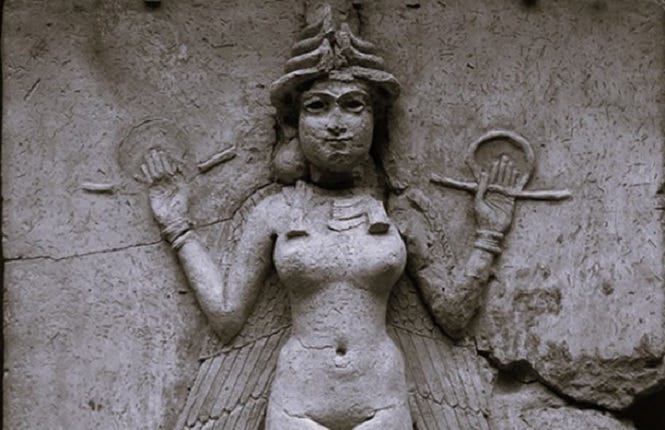Ishtar: Goddess of Mesopotamia
The first stop on our journey is in Mesopotamia where references to Ishtar (or Esh-Tar) stretch back to around 2400 BCE. Ishtar is also linked to a Sumerian goddess called Inanna, mentions of who stretch back to around 3000 BCE. This makes our Mediterranean goddess possible over 5000 years old.
Depending on the myth Ishtar is the daughter of Nanna, the god of the moon; or Enlil, the god of the wind; or Anu the god of the heavens. Ishtar was often described as a young woman and was characterized as impulsive. She is sometimes linked to death, chaos, natural disasters, and fire.
She had many lovers and different husbands. She even is said to have accompanied one of her husbands into battle making her a war goddess. Aside from war, Ishtar is a goddess of love, beauty, sex, and fertility. Her temples practiced temple prostitution and she was a patroness of alehouses. Ishtar is also an astral deity. One of her main symbols is a six-pointed star in a circle. She is also associated with the planet Venus.
Ishtar’s worship spanned the entire Middle East. Evidence of her cult can be found in Syria, Palestine, Phonecia, and Arabia. She was merged with numerous local goddesses. In fact, it was in the land of Canaan that Ishtar evolved into the goddess Astarte.
References
Join us next month as we journey to Canaan and Phonecia to learn about the goddess Astarte.
Astarte: Goddess of Canaan
As we move to the next stop tracking the evolution of the Mediterranean Goddess Astarte is the form we know the least about. She was known by many other names such as Ashtar, Ashtart, Ashtoret, and Ashtaroth. The difference in her name and image from region to region makes it harder to find information about her. She was a goddess of war and sexual love…





